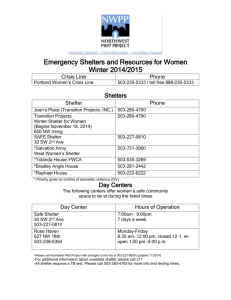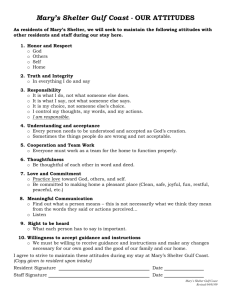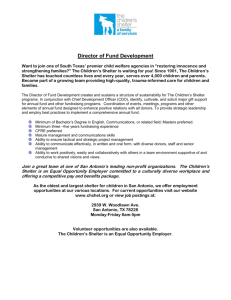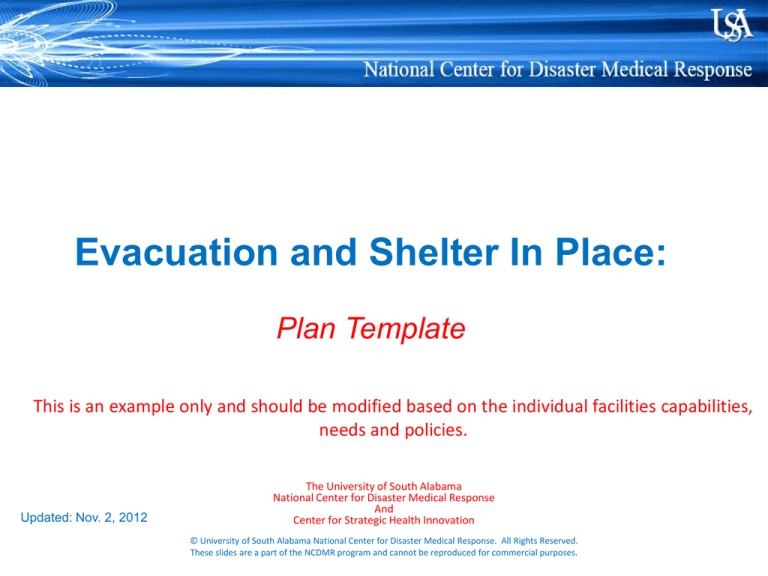
Evacuation and Shelter In Place:
Plan Template
This is an example only and should be modified based on the individual facilities capabilities,
needs and policies.
Updated: Nov. 2, 2012
The University of South Alabama
National Center for Disaster Medical Response
And
Center for Strategic Health Innovation
© University of South Alabama National Center for Disaster Medical Response. All Rights Reserved.
These slides are a part of the NCDMR program and cannot be reproduced for commercial purposes.
Table of Contents
Table of Contents
Section 1:
Plan Review and Update Form
Section 2:
Sample Plan- Shelter in Place
• Shelter in Place Decision Tree
• Shelter in Place Checklist
Section 3:
Sample Plan- Evacuation
• Incident Command Responsibilities
• Nursing Home Evacuation and Shelter in Place Decision Tree
• Evacuation Decision Trees – Pre and Post Event
Section 4:
Evacuation/Shelter in Place Planning Document
Section 5:
General Forms
• Resident Information Evacuation Form
• Transportation Log for Evacuated Residents
Section 6:
Resource Materials
• FHCA Disaster Information
• FHCA External and Internal Disaster Drill Form
• Nursing Home Incident Command System: A Quick Guide to Job Responsibilities and Authorities
• Nursing Home Incident Command System: Form 254 – Master Emergency Admit Tracking Form
• Sample Mutual Aid Transfer Agreement
• National Criteria for Evacuation Decision Making in Nursing Homes
• Department of Health and Human Services Office of the Inspector General:
Nursing Home Emergency Preparedness and Response During Recent Hurricanes
• AHRQ Hospital Evacuation Decision Guide
Headers for Each
Section of the
Header for each Section of Plan:
Section:
Procedure #
Effective Date:
Revision Date:
Revision #:
Subject:
Page:
Reviewed by:
Approved by:
Review and Initial
Record Form
Date Plan Adopted: ______________________________________________
•
1st Annual Review and Update: ______________ Completed by: ________________________
Changes Made: _____________________________________________________________
•
2nd Annual Review and Update: ______________
Completed by: ________________________
Changes Made: ______________________________________________________________
Note:
This is a record of annual review of the Plan as well as a
synopsis of any changes made to the Plan
Sample Plan
POLICY:
It is the policy of FACILITY NAME to ensure the safety and well being of all residents, staff members and
visitors in this facility at all times. In certain situations, such as tornado or chemical incident, etc., facility
name may be ordered by local, emergency management, state or federal authorities to stay and shelter in
place. Should Shelter in place become necessary, residents will be moved to a safe inner facility location
in an effective, organized and safe manner that is conducive to ensuring continuity of resident care,
sustainability and safety for short and long term.
The plan will be consistent with state and federal regulations including, but not limited to NIMS.
PURPOSE:
To provide a plan of action for nursing home personnel to move residents and staff to an internal facility
location which is the safest location during an event as described above.
This plan must include detailed information for development, activation and update of the nursing home
shelter in place plan. The plan will also contain information, instructions and procedures that can be
engaged in during any emergency situation that may necessitate either full or partial nursing home
shelter in place, as well as evacuation.
The expectation is that the nursing home facility may need to be self sustaining with resources such as staff,
space, supplies, medications, equipment, food, water, and emergency utilities such as power, water, fuel
and medical gases for a minimum of 72 hours.
Drills and staff education must be conducted in accordance with NFPA 99 (1999 version, Chapter 11) to
ensure that staff have a working knowledge of the plan and are capable of activating and performing the
shelter in place process.
SCOPE AND
APPLICABILITY
SCOPE AND APPLICABILITY:
•
•
This Plan applies to all staff, residents and visitors present at the time of the emergency.
Shelter in place can be indicated and performed as any combination of the following:
– Pre-event shelter in place - based on imminent danger related to a disaster event
– Post-event shelter in place - facility incurs structural damage or loss of infrastructure
– Shelter in Place -residents are transferred within the facility (horizontally or vertically to a safe
location within the facility)
– Vertical Shelter in place- movement of residents to a safe area on another floor or outside the
building. Considerations must be made for moving non-ambulatory residents up and down stairs
without the use of elevators
– Horizontal shelter in place- first response of moving residents from a single danger area to another
area on the same floor or may be in a hallway or inner corridor or room within the facility.
Activation Authority
ACTIVATION AUTHORITY:
•
•
•
•
Activate the Incident Command Structure at the designated or alternate IC location
Shelter in place of the facility can only be authorized by:
– Authority Having Jurisdiction (i.e., Fire or Police)
– Administrator or Administrator On-Call
– Facility Safety Officer
– Chief Nursing Officer
– Designated Incident Commander
(Note: Each nursing home or other healthcare facility should outline who has shelter in place activation
decision making authority.)
The decision to shelter in place from unsafe or damaged areas shall be based on the following information:
(Pre- Event Decision Algorithm: Appendix # __ and Post Event Decision Tree- Appendix # ____)
– The Plant Operations Department’s evaluation of the utilities and/or structure of the department.
– The Medical Staff and/or Nursing Department’s determination of whether adequate resident care can
continue
– Shelter in place should be undertaken whenever there is imminent danger.
Procedure
PROCEDURE:
•
Activation Process:
–
•
Communication of shelter in place:
–
•
Shelter in place will be initiated via activation of Code _____ and will consist of the following:
• Internal
– Notification over PA system to all staff, residents and visitors
• External Communication
– Activation and notification of external resources
» Notify EMA, ADPH and EMS of shelter in place
» Public Information Officer• Statements regarding shelter in place
• Facility on diversion/open?
• Off duty nursing home staff instructions
• Resident families instructions
Security
–
•
Activate the Incident Command Structure in Incident Command Center
• All responsible Section Chiefs outlined in ICS shall assume their roles and responsibilities (See appendix #___)
Activate levels of security as deemed necessary utilizing:
• Internal Resources (Specify)
• External Resources (Specify)
Shelter in place Process
–
Determine and activate type of shelter in place needed based on disaster impact:
• Partial
• Complete
• Vertical
• Horizontal
Resident Shelter-in-place
Process:
Resident Shelter in place Process:
–
–
–
–
–
Resident care will continue to be provided as close to normal as possible
» SIP location should have access to oxygen, medications, medical supplies, water, food, and sanitary supplies
» SIP location for secured access areas should also have like capability of providing the same secured access to
ensure no patient elopement occurs
» Minimum staffing levels should be maintained at all times to facilitate adequate shelter in place care (Preplanning should identify this number based on resident census numbers)
» Resident care staff are to continuously monitor resident medical conditions to prevent deterioration where
possible
Shelter in place Equipment/Resources locations (see appendix # _____)
» Shelter in place equipment will be located on each floor at the __ ___ and will consist of:
• Stair chairs
• Etc…..
Process for moving residents vertically or horizontally:
» Elevators can be used- except during or after : a fire, if significant seismic activity or if there is evident
infrastructure damage which hinders function and safety of elevator system
» If elevators are not available for vertical sheltering in place, residents are to be manually sheltered in placed via
the stairs
Moving equipment, supplies, medication necessary to ensure continuity of resident care: (APPENDIX # ____ checklist)
» The following are to be maintained for resident shelter in place:
• Medications
• Medical supplies.
• Sanitary supplies
• Food, and water
» Shelter in placed areas should be secured by closing doors and moving patients away from windows
Resident Staging areas for shelter in place (identify and list)
• NOTE: Lists of required shelter in place necessities should be developed in advance, along with minimal amount of food and water required to sustain
residents for a 96 hour period of time and should be listed an appendix document
Procedure Continued
•
Continuity of Operations:
–
–
•
Repopulation or Evacuation of Shelter in placed Facilities
–
–
–
–
•
Describe plan for continued provision of essential utilities such as:
• Power – see BLUE BOOK
• Water
• Medical gases
Describe plan for provision of essential resident care needs:
• Medications
• Food
• Water
• Supplies
• Equipment
Define procedure to include ensuring the facility is: structurally and physically safe, secure and all resources are available for
reopening.
Define who will evaluate and deem facility safe for re-opening
Define re population process
Reference evacuation plan document if evacuation is indicated during the SIP process
Training, Exercises and Drills
–
Define: REMINDER – Cite Blue Book/ LSC
• Frequency of training
• Who will participate in the training
• Training content
• Drills/Exercises – type and frequency
Appendices / Resources
Appendices
–
–
–
–
–
–
IC Chart and Job action responsibilities (Section
Chiefs)
Shelter in place Decision Tree
Shelter in place maps/diagrams
Shelter in place checklists
Maps and List of shelter in place
equipment/supplies
List of Contacts
• External
– EMA
– ADPH
– EMS
– Family Notifications
– Public Information Outreach
• Internal
– Staff lists and contact information
Resource Materials
•
•
•
•
•
•
•
•
FHCA Disaster Information
FHCA External and Internal Disaster Drill
Form
Nursing Home Incident Command System:
A Quick Guide to Job Responsibilities and
Authorities
Nursing Home Incident Command System:
Form 254 – Master Emergency Admit
Tracking Form
Sample Mutual Aid Transfer Agreement
National Criteria for Evacuation Decision
Making in Nursing Homes
Department of Health and Human Services
Office of the Inspector General:
Nursing Home
Emergency Preparedness and Response
During Recent Hurricanes
AHRQ Hospital Evacuation Decision Guide
Top Reasons for successful evacuation of
a hospital facility:
•
•
•
PLANNING
Good Decisions
Drills/Exercises
Questions?



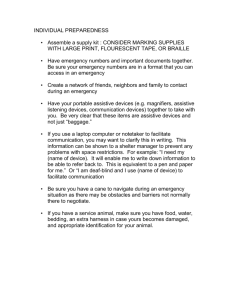


![Action Plan Training for College of Education [Erickson Hall]](http://s3.studylib.net/store/data/006838784_1-e08201da1f024d72d03dde66b95777a5-300x300.png)
